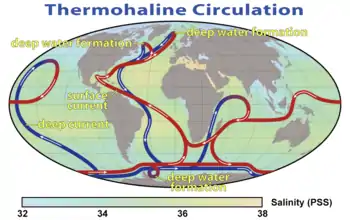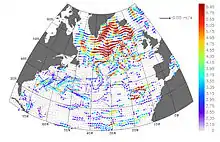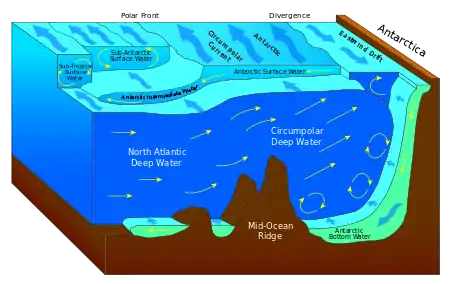Shutdown of thermohaline circulation
A shutdown or slowdown of the thermohaline circulation is a hypothesized effect of global warming on a major ocean circulation.

A 2015 study suggested that the Atlantic meridional overturning circulation (AMOC) has weakened by 15-20% in 200 years.[1]
General
Don Chambers from the University of South Florida College of Marine Science mentioned: "The major effect of a slowing AMOC is expected to be cooler winters and summers around the North Atlantic, and small regional increases in sea level on the North American coast."[2] James Hansen and Makiko Sato stated:
AMOC slowdown that causes cooling ~1 °C and perhaps affects weather patterns is very different from an AMOC shutdown that cools the North Atlantic several degrees Celsius; the latter would have dramatic effects on storms and be irreversible on the century time scale.[3]
Downturn of the Atlantic meridional overturning circulation has been tied to extreme regional sea level rise.[4]
A 2017 review concluded that there is strong evidence for past changes in the strength and structure of the AMOC during abrupt climate events such as the Younger Dryas and many of the Heinrich events.[5]
Slowdown
Lohmann and Dima 2010 found a weakening of the AMOC since the late 1930s.[6] Climate scientists Michael Mann of Penn State and Stefan Rahmstorf from the Potsdam Institute for Climate Impact Research suggested that the observed cold pattern during years of temperature records is a sign that the Atlantic Ocean's Meridional overturning circulation (AMOC) may be weakening. They published their findings in 2015, and concluded that the AMOC circulation showed exceptional slowdown in the last century, and that Greenland melt is a possible contributor, with the slowdown of AMOC since the 1970s being unprecedented over the last millennium.[7]
A study published in 2016 found further evidence for a considerable impact from sea level rise for the U.S. East Coast. The study confirms earlier research findings which identified the region as a hotspot for rising seas, with a potential to divert 3–4 times in the rate of rise, compared to the global average. The researchers attribute the possible increase to an ocean circulation mechanism called deep water formation, which is reduced due to AMOC slow down, leading to more warmer water pockets below the surface. Additionally, the study noted, "Our results suggest that higher carbon emission rates also contribute to increased [sea level rise] in this region compared to the global average."[8]
Shutdown
Global warming could, via a shutdown of the thermohaline circulation, trigger cooling in the North Atlantic, Europe, and North America.[9][10] This would particularly affect areas such as the British Isles, France and the Nordic countries, which are warmed by the North Atlantic drift.[11][12] Major consequences, apart from regional cooling, could also include an increase in major floods and storms, a collapse of plankton stocks, warming or rainfall changes in the tropics or Alaska and Antarctica, more frequent and intense El Niño events due to associated shutdowns of the Kuroshio, Leeuwin, and East Australian Currents that are connected to the same thermohaline circulation as the Gulf Stream, or an oceanic anoxic event — oxygen (O
2) below surface levels of the stagnant oceans becomes completely depleted – a probable cause of past mass extinction events.[13]
Effects on weather
Hansen et al. 2015 found, that the shutdown or substantial slowdown of the AMOC, besides possibly contributing to extreme end-Eemian events, will cause a more general increase of severe weather. Additional surface cooling from ice melt increases surface and lower tropospheric temperature gradients, and causes in model simulations a large increase of mid-latitude eddy energy throughout the midlatitude troposphere. This in turn leads to an increase of baroclinicity produced by stronger temperature gradients, which provides energy for more severe weather events.
Many of the most memorable and devastating storms in eastern North America and western Europe, popularly known as superstorms, have been winter cyclonic storms, though sometimes occurring in late fall or early spring, that generate near-hurricane-force winds and often large amounts of snowfall. Continued warming of low latitude oceans in coming decades will provide more water vapor to strengthen such storms. If this tropical warming is combined with a cooler North Atlantic Ocean from AMOC slowdown and an increase in midlatitude eddy energy, we can anticipate more severe baroclinic storms.
Hansen et al. results at least imply that strong cooling in the North Atlantic from AMOC shutdown does create higher wind speed. The increment in seasonal mean wind speed of the northeasterlies relative to preindustrial conditions is as much as 10–20%. Such a percentage increase of wind speed in a storm translates into an increase of storm power dissipation by a factor ∼1.4–2, because wind power dissipation is proportional to the cube of wind speed. However, the simulated changes refer to seasonal mean winds averaged over large grid-boxes, not individual storms.[14]
Observations
2010 and earlier
In April 2004, the hypothesis that the Gulf Stream is switching off received a boost when a retrospective analysis of U.S. satellite data seemed to show a slowing of the North Atlantic Gyre, the northern swirl of the Gulf Stream.[15]
In May 2005, Peter Wadhams reported in The Times (London) about the results of investigations in a submarine under the Arctic ice sheet measuring the giant chimneys of cold dense water, in which the cold dense water normally sinks down to the sea bed and is replaced by warm water, forming one of the engines of the North Atlantic Drift. He and his team found the chimneys to have virtually disappeared. Normally there are seven to twelve giant columns, but Wadhams found only two giant columns, both extremely weak.[16][17]
In 2005 a 30% reduction in the warm currents that carry water north from the Gulf Stream was observed from the last such measurement in 1992. The authors noted uncertainties in the measurements.[18] Following media discussions, Detlef Quadfasel pointed out that the uncertainty of the estimates of Bryden et al. is high, but says other factors and observations do support their results, and implications based on palaeoclimate records show drops of air temperature up to 10 °C within decades, linked to abrupt switches of ocean circulation when a certain threshold is reached. He concluded that further observations and modelling are crucial for providing early warning of a possible devastating breakdown of the circulation.[19] In response Quirin Schiermeier concluded that natural variation was the culprit for the observations but highlighted possible implications.[13][20]
In 2008, Vage et al. reported "the return of deep convection to the subpolar gyre in both the Labrador and Irminger seas in the winter of 2007–2008," employing "profiling float data from the Argo program to document deep mixing," and "a variety of in situ, satellite and reanalysis data" to set the context for the phenomenon. This might have a lot to do with the observations of variations in cold water chimney behaviour.[21]
In January 2010, the Gulf Stream briefly connected with the West Greenland Current after fluctuating for a few weeks due to an extreme negative phase of the Arctic oscillation, temporarily diverting it west of Greenland.[22][23]
Thermohaline circulation and fresh water

Heat is transported from the equator polewards mostly by the atmosphere but also by ocean currents, with warm water near the surface and cold water at deeper levels. The best known segment of this circulation is the Gulf Stream, a wind-driven gyre, which transports warm water from the Caribbean northwards. A northwards branch of the Gulf Stream, the North Atlantic Drift, is part of the thermohaline circulation (THC), transporting warmth further north to the North Atlantic, where its effect in warming the atmosphere contributes to warming Europe.
The evaporation of ocean water in the North Atlantic increases the salinity of the water as well as cooling it, both actions increasing the density of water at the surface. Formation of sea ice further increases the salinity and density, because salt is ejected into the ocean when sea ice forms.[24] This dense water then sinks and the circulation stream continues in a southerly direction. However, the Atlantic Meridional Overturning Circulation (AMOC) is driven by ocean temperature and salinity differences. But freshwater decreases ocean water salinity, and through this process prevents colder waters sinking. This mechanism possibly caused the cold ocean surface temperature anomaly currently observed near Greenland (Cold blob (North Atlantic)).[25]
Global warming could lead to an increase in freshwater in the northern oceans, by melting glaciers in Greenland, and by increasing precipitation, especially through Siberian rivers.[26][27]
An AMOC shutdown may be able to trigger the type of abrupt massive temperature shifts which occurred during the last glacial period: a series of Dansgaard-Oeschger events – rapid climate fluctuations – may be attributed to freshwater forcing at high latitude interrupting the THC. 2002 model runs in which the THC is forced to shut down do show cooling – locally up to 8 °C (14 °F).[28]
Studies of the Florida Current suggest that the Gulf Stream weakens with cooling, being weakest (by ~10%) during the Little Ice Age.[29]
Subpolar gyre
Recent studies (2017) suggest potential convection collapse (heat transport) of the subpolar gyre in the North Atlantic, resulting in rapid cooling, with implications for economic sectors, agriculture industry, water resources and energy management in Western Europe and the East Coast of the United States.[30] Frajka-Williams et al. 2017 pointed out that recent changes in cooling of the subpolar gyre, warm temperatures in the subtropics and cool anomalies over the tropics, increased the spatial distribution of meridional gradient in sea surface temperatures, which is not captured by the AMO Index.[31]
IPCC models
Based on coupled Atmosphere-Ocean General Circulation Models from 2001, the THC tends to weaken somewhat rather than stop, and the warming effects outweigh the cooling, even over Europe.[32] In the IPCC Fifth Assessment Report, it was reported that it is very unlikely that the AMOC will undergo a rapid transition (high confidence).[33]
In popular culture
The film The Day After Tomorrow exaggerates a scenario related to the AMOC shutdown.
Kim Stanley Robinson's science-fiction novel Fifty Degrees Below, a volume in his Science in the Capital series, depicts a shutdown of thermohaline circulation & mankind's efforts to counteract it by adding great quantities of salt to the ocean.
In Ian Douglas' Star Corpsman novels, an AMOC shutdown triggered an early glacial maximum, covering most of Canada and northern Europe in ice sheet by the mid-22nd century.
See also
- 8.2 kiloyear event
- Climate security
- Loop Current of the Gulf of Mexico
- Oceanic anoxic event
- Pacific Decadal Oscillation
- Paleosalinity, changes in which are thought to slow down the THC
- Thermohaline_circulation
- West Greenland Current
- Younger_Dryas
References
- Rahmstorf, Stefan; Box, Jason E.; Feulner, Georg; Mann, Michael E.; Robinson, Alexander; Rutherford, Scott; Schaffernicht, Erik J. (2015). "Exceptional twentieth-century slowdown in Atlantic Ocean overturning circulation" (PDF). Nature Climate Change. 5 (5): 475–480. Bibcode:2015NatCC...5..475R. doi:10.1038/nclimate2554. ISSN 1758-678X.
 PDF in UNEP Document Repository
PDF in UNEP Document Repository - University of South Florida (22 January 2016). "Melting Greenland ice sheet may affect global ocean circulation, future climate". Phys.org.
- Hansen, James; Sato, Makiko (2015). "Predictions Implicit in "Ice Melt" Paper and Global Implications".
- Yin, Jianjun & Griffies, Stephen (25 March 2015). "Extreme sea level rise event linked to AMOC downturn". CLIVAR.
- Jean Lynch-Stieglitz (2017). "The Atlantic Meridional Overturning Circulation and Abrupt Climate Change". Annual Review of Marine Science. Bibcode:2017ARMS....9...83L. doi:10.1146/annurev-marine-010816-060415.
- Mihai Dima; Gerrit Lohmann (2010). "Evidence for Two Distinct Modes of Large-Scale Ocean Circulation Changes over the Last Century" (PDF). Journal of Climate. 23 (1): 5–16. Bibcode:2010JCli...23....5D. doi:10.1175/2009JCLI2867.1.
- Stefan Rahmstorf; Jason E. Box; Georg Feulner; Michael E. Mann; Alexander Robinson; Scott Rutherford; Erik J. Schaffernicht (2015). "Exceptional twentieth-century slowdown in Atlantic Ocean overturning circulation" (PDF). Nature. 5 (5): 475–480. Bibcode:2015NatCC...5..475R. doi:10.1038/nclimate2554.
- Mooney, Chris (1 February 2016). "Why the U.S. East Coast could be a major 'hotspot' for rising seas". The Washington Post.
- University Of Illinois At Urbana-Champaign (20 December 2004). "Shutdown Of Circulation Pattern Could Be Disastrous, Researchers Say". ScienceDaily.
- "Possible Economic Impacts of a Shutdown of the Thermohaline Circulation: an Application of FUND". CiteSeerX 10.1.1.175.5994. Cite journal requires
|journal=(help) - "Weather Facts: North Atlantic Drift (Gulf Stream) - Weather UK - weatheronline.co.uk".
- "The North Atlantic Drift Current".
- Schiermeier, Quirin (2007). "Ocean circulation noisy, not stalling". Nature. 448 (7156): 844–5. Bibcode:2007Natur.448..844S. doi:10.1038/448844b. PMID 17713489.
- J. Hansen, M. Sato, P. Hearty, R. Ruedy, M. Kelley, V. Masson-Delmotte, G. Russell, G. Tselioudis, J. Cao, E. Rignot, I. Velicogna, E. Kandiano, K. von Schuckmann, P. Kharecha, A. N. Legrande, M. Bauer, and K.-W. Lo (2015). "Ice melt, sea level rise and superstorms: evidence from paleoclimate data, climate modeling, and modern observations that 2 °C global warming is highly dangerous". Atmospheric Chemistry and Physics Discussions. 15 (14): 20059–20179. Bibcode:2015ACPD...1520059H. doi:10.5194/acpd-15-20059-2015.CS1 maint: multiple names: authors list (link)
- Satellites record weakening North Atlantic Current. NASA, 15 April 2004.
- Leake, Jonathan (8 May 2005). "Britain faces big chill as ocean current slows". The Sunday Times.
- Gulf Stream slowdown? RealClimate.org, 26 May 2005.
- F. Pearce. Failing ocean current raises fears of mini ice age. NewScientist, 30 November 2005
- Quadfasel D (December 2005). "Oceanography: The Atlantic heat conveyor slows". Nature. 438 (7068): 565–6. Bibcode:2005Natur.438..565Q. doi:10.1038/438565a. PMID 16319866.
- Schiermeier, Quirin (2007). "Climate change: A sea change". Nature. 439 (7074): 256–60. Bibcode:2006Natur.439..256S. doi:10.1038/439256a. PMID 16421539. (subscription required); see also "Atlantic circulation change summary". RealClimate.org. 19 January 2006.
- Våge, Kjetil; Pickart, Robert S.; Thierry, Virginie; Reverdin, Gilles; Lee, Craig M.; Petrie, Brian; Agnew, Tom A.; Wong, Amy; Ribergaard, Mads H. (2009). "Surprising return of deep convection to the subpolar North Atlantic Ocean in winter 2007–2008". Nature Geoscience. 2 (1): 67–72. Bibcode:2009NatGe...2...67V. doi:10.1038/ngeo382.
- Birchard, George (6 January 2010). "Freak Current Takes Gulf Stream to Greenland". Daily Kos. Retrieved 11 January 2010.
- Birchard, George (30 December 2009). "Warm Atlantic Water Rapidly Replacing Arctic Sea Ice". Daily Kos. Retrieved 11 January 2010.
- "Salinity and Brine". NSIDC.
- Mooney, Chris (30 September 2015). "Everything you need to know about the surprisingly cold 'blob' in the North Atlantic ocean". The Washington Post.
- Gierz, Paul (31 August 2015). "Response of Atlantic Overturning to future warming in a coupled atmosphere-ocean-ice sheet model". Geophysical Research Letters. 42 (16): 6811–6818. Bibcode:2015GeoRL..42.6811G. doi:10.1002/2015GL065276.
- Turrell, B. The Big Chill Transcript of discussion on BBC 2, 13 November 2003
- Vellinga, M.; Wood, R.A. (2002). "Global climatic impacts of a collapse of the Atlantic thermohaline circulation" (PDF). Climatic Change. 54 (3): 251–267. doi:10.1023/A:1016168827653. Archived from the original (PDF) on 6 September 2006.
- Lund DC, Lynch-Stieglitz J, Curry WB; Lynch-Stieglitz; Curry (November 2006). "Gulf Stream density structure and transport during the past millennium" (PDF). Nature. 444 (7119): 601–4. Bibcode:2006Natur.444..601L. doi:10.1038/nature05277. PMID 17136090.CS1 maint: multiple names: authors list (link)
- Sgubin; et al. (2017). "Abrupt cooling over the North Atlantic in modern climate models". Nature Communications. 8. Bibcode:2017NatCo...8.....S. doi:10.1038/ncomms14375. PMC 5330854. PMID 28198383.
- Eleanor Frajka-Williams; Claudie Beaulieu; Aurelie Duchez (2017). "Emerging negative Atlantic Multidecadal Oscillation index in spite of warm subtropics". Scientific Reports. 7 (1): 11224. Bibcode:2017NatSR...711224F. doi:10.1038/s41598-017-11046-x. PMC 5593924. PMID 28894211.
- IPCC TAR WG1 (2001). "9.3.4.3 Thermohaline circulation changes". In Houghton, J.T.; Ding, Y.; Griggs, D.J.; Noguer, M.; van der Linden, P.J.; Dai, X.; Maskell, K.; Johnson, C.A. (eds.). Climate Change 2001: The Scientific Basis. Contribution of Working Group I to the Third Assessment Report of the Intergovernmental Panel on Climate Change. Cambridge University Press. ISBN 978-0-521-80767-8. (pb: 0-521-01495-6)
- "IPCC AR5 WG1" (PDF). IPCC. IPCC. p. Table 12.4. Archived from the original (PDF) on 24 August 2015.
External links
- Project THOR University of Hamburg project to study the thermohaline circulation
- "An Abrupt Climate Change Scenario and Its Implications for United States National Security" (2003 study)
- What If the Conveyor Were to Shut Down? Reflections on a Possible Outcome of the Great Global Experiment (1999 study)
- A Nasty Surprise in the Greenhouse (Video about the shutdown of the thermohaline circulation, 2015)
- Why is there a thermohaline circulation in the Atlantic but not the Pacific? (2005 technical report)

